1998 VOLVO V90 trailer
[x] Cancel search: trailerPage 91 of 175

1998 Volvo S90
Chapter 6 - (cont.)
Replacing bulbs
pg. 81
Replacing bulbs
The method for replacement of bulbs in
the various lighting units is shown on the
following pages. Make sure when
installing bulbs, that the guide pin on the
socket fits into its corresponding recess.
When installing Halogen bulbs, do not
touch the glass with your fingers because
grease, oil or any other impurities can be
carbonized onto the bulb and damage the
reflector.
Use bulbs of correct type and voltage.
Failure to do so could cause the bulb
failure warning light to activate.
NOTE: Turn the ignition and light
switch off before replacing any bulbs.
Headlights (high/low beams)
1. Press the protruding tabs on the plastic
cover and pull out towards the fender.
2. Turn the bulb and connector 1/4 turn
counterclockwise and remove.
3. Remove the connector from the bulb.
4. Press a new bulb into the connector
without touching the bulb itself.
5. Reinsert the bulb into the headlight
housing and turn 1/4 turn clockwise until
the unit seats properly.
6. Reinstall the plastic cover.
Bulb Power US Bulb No.
High beam 70W HB3/9005
Low beam 60W HB4/9006
Headlight adjustment
The height of the headlight beams can be
adjusted according to vehicle load. The
headlights should be re-aimed if heavy
loads are carried in the trunk/cargo area or
rear seat, or when towing a trailer.
To adjust the headlights:
Park the car on a level surface and open
the hood.
The headlights are equipped with a level
which can be seen by looking through the
clear "window" on the top of the headlight
lens.
Turn the height adjustment knob (A) until
the bubble in the level aligns with within
the marking lines on the level.
Lateral headlight adjustment (B) should
only be carried out by an authorized
Volvo retailer. This setting should be
preset to "0".
Replacing bulbs pg. 82
file:///K|/ownersdocs/1998/1998_SV90/98S90_081.htm (1 of 6)12/30/2006 \
1:52:45 PM
Page 99 of 175
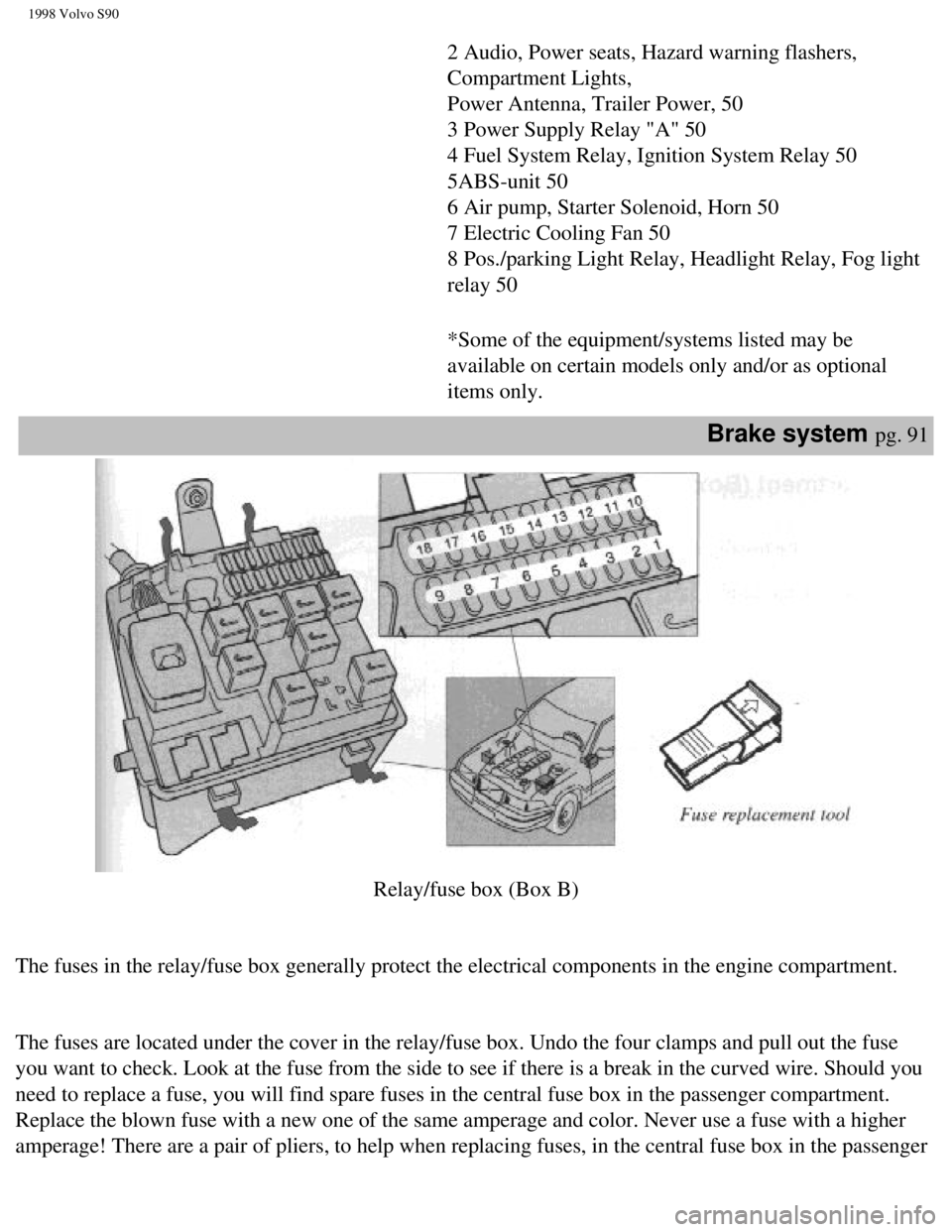
1998 Volvo S90
2 Audio, Power seats, Hazard warning flashers,
Compartment Lights,
Power Antenna, Trailer Power, 50
3 Power Supply Relay "A" 50
4 Fuel System Relay, Ignition System Relay 50
5ABS-unit 50
6 Air pump, Starter Solenoid, Horn 50
7 Electric Cooling Fan 50
8 Pos./parking Light Relay, Headlight Relay, Fog light
relay 50
*Some of the equipment/systems listed may be
available on certain models only and/or as optional
items only.
Brake system pg. 91
Relay/fuse box (Box B)
The fuses in the relay/fuse box generally protect the electrical compone\
nts in the engine compartment.
The fuses are located under the cover in the relay/fuse box. Undo the fo\
ur clamps and pull out the fuse
you want to check. Look at the fuse from the side to see if there is a b\
reak in the curved wire. Should you
need to replace a fuse, you will find spare fuses in the central fuse bo\
x in the passenger compartment.
Replace the blown fuse with a new one of the same amperage and color. Ne\
ver use a fuse with a higher
amperage! There are a pair of pliers, to help when replacing fuses, in t\
he central fuse box in the passenger
file:///K|/ownersdocs/1998/1998_SV90/98S90_089.htm (3 of 9)12/30/2006 \
1:52:46 PM
Page 101 of 175

1998 Volvo S90
Location ** Amperage
1 Heated rear window 25
2 Central locking 20
3 Brake light, Light switch 15
4 Ignition switch, SRS 10
5 Spare
6 Windshield wiper/washer, Headlight wiper, horn relay 25
7 Climate unit 20
8 Power pass. seat, Power side-view mirrors, Tailgate wiper/washer (wag\
ons)
Instrument lighting, Ambient temp. sensor 15
9 Audio system 15
10 Cigarette lighter/accessory socket 15
11 Transmission mode selector, Gear selector light 5
12 ABS 5
13 Clock, Interior/glove compartment lighting, Door open warning lights,\
Cargo space lighting, Vanity mirror 10
14 Horn 10
Location ** Amperage
15 Power antenna, Headlight flasher, Trailer 20
16 Accessories 20
17 Hazard warning flasher, Direction indicator, Alarm hazard indication \
20
18 Audio/amplifier, CD changer 15
file:///K|/ownersdocs/1998/1998_SV90/98S90_089.htm (5 of 9)12/30/2006 \
1:52:46 PM
Page 120 of 175
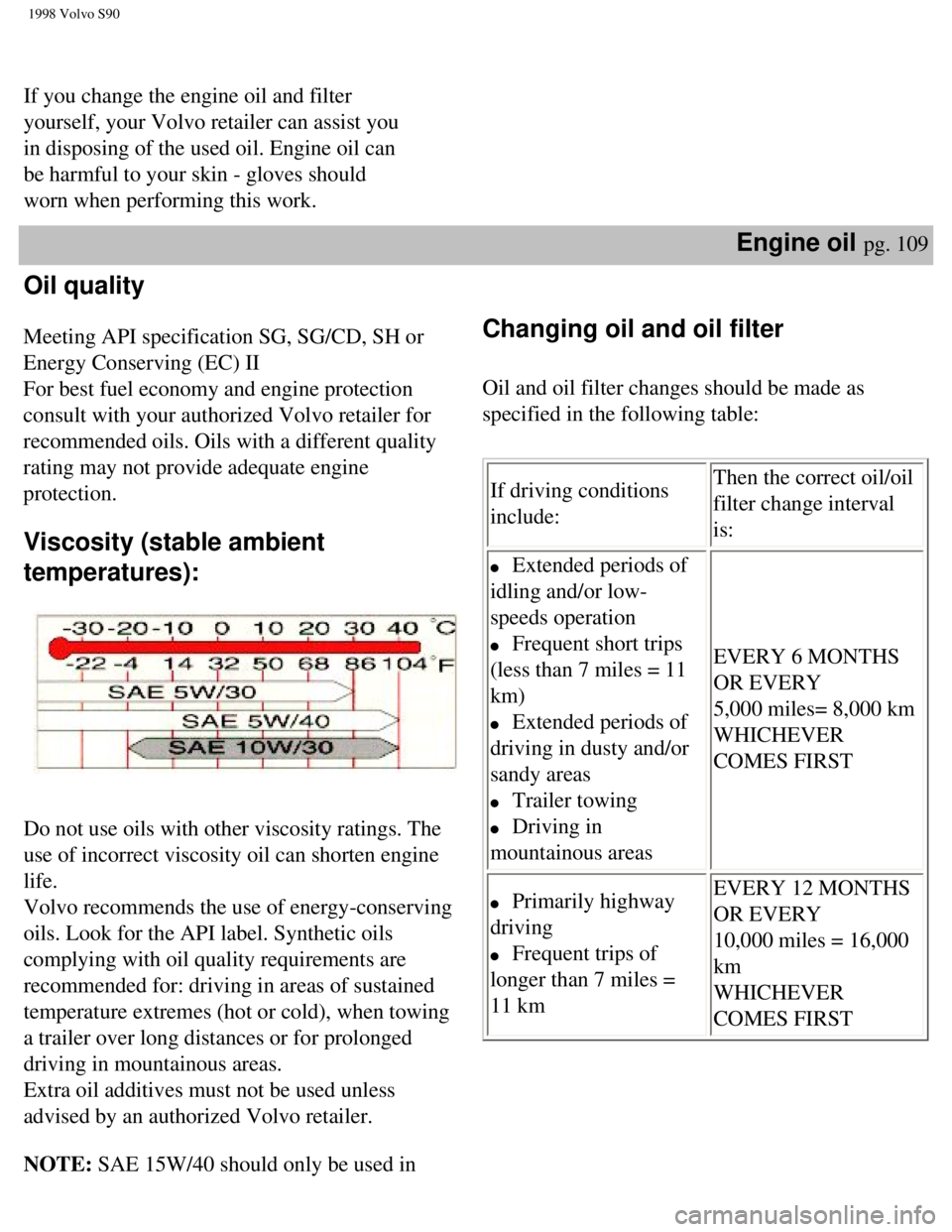
1998 Volvo S90
If you change the engine oil and filter
yourself, your Volvo retailer can assist you
in disposing of the used oil. Engine oil can
be harmful to your skin - gloves should
worn when performing this work.
Engine oil pg. 109
Oil quality
Meeting API specification SG, SG/CD, SH or
Energy Conserving (EC) II
For best fuel economy and engine protection
consult with your authorized Volvo retailer for
recommended oils. Oils with a different quality
rating may not provide adequate engine
protection.
Viscosity (stable ambient
temperatures):
Do not use oils with other viscosity ratings. The
use of incorrect viscosity oil can shorten engine
life.
Volvo recommends the use of energy-conserving
oils. Look for the API label. Synthetic oils
complying with oil quality requirements are
recommended for: driving in areas of sustained
temperature extremes (hot or cold), when towing
a trailer over long distances or for prolonged
driving in mountainous areas.
Extra oil additives must not be used unless
advised by an authorized Volvo retailer.
NOTE: SAE 15W/40 should only be used in
Changing oil and oil filter
Oil and oil filter changes should be made as
specified in the following table:
If driving conditions
include: Then the correct oil/oil
filter change interval
is:
l Extended periods of
idling and/or low-
speeds operation
l Frequent short trips
(less than 7 miles = 11
km)
l Extended periods of
driving in dusty and/or
sandy areas
l Trailer towing
l Driving in
mountainous areas EVERY 6 MONTHS
OR EVERY
5,000 miles= 8,000 km
WHICHEVER
COMES FIRST
l Primarily highway
driving
l Frequent trips of
longer than 7 miles =
11 km EVERY 12 MONTHS
OR EVERY
10,000 miles = 16,000
km
WHICHEVER
COMES FIRST
file:///K|/ownersdocs/1998/1998_SV90/98S90_108.htm (2 of 6)12/30/2006 \
1:52:49 PM
Page 121 of 175

1998 Volvo S90
extreme operating conditions such as trailer
towing in sustained ambient temperatures over
104° F (40° C). However, SAE 10W-30 synthetic
oil would be a better alternative in such
conditions.
SAE 15W-40 should not be used under normal
operating conditions.
American Petroleum Institute
(API) labels. These labels certify
the oil conforms to the applicable
standards and specifications of
the API.
Servicing pg. 110
Torque exhaust and
intake manifold nuts
A loose manifold could alter air/
fuel ratio and cause an increase
in emissions and/or poor
driveability.
Air cleaner
Replace the air cleaner cartridge
with a new one every 30,000
miles (48,000 km). The
cartridge should be replaced
more often when driving under
dirty and dusty conditions, The
filter cannot be cleaned and,
therefore, should always be
replaced with a new one.
Vacuum fittings, hoses
and connections
Unstable idle, misfiring, or poor
emission control is often caused
by leaking vacuum hoses or
connections. Check hoses and
connections on distributor
vacuum unit, connections on
heater control servo systems and
hydraulic brake servo.
Fuel system cap, tank
and lines, and
connections
The effectiveness of the fuel
system to contain hydrocarbons
is dependent largely on a
leakfree system. Check for
proper sealing of gasoline filler
cap which contains "O" ring-
type seals. Check all
evaporative hoses in vehicle for
tightness. Check fuel lines under
vehicle and repair if necessary.
Fuel (line) filter
The fuel line filter is located
next to the fuel pump. This filter
should be replaced every
100,000 miles (160,000 km).
The filter is replaced as one
complete unit.
Replace more frequently if
contaminated fuel is introduced
into the tank (or if there is
reason to suspect that this has
occurred).
Timing belt
WARNING!
The distributor ignition
system operates at very high
voltages. Special safety
precautions must be followed
to prevent injury.
Always turn the ignition off
when:
l Replacing distributor
ignition components e.g.
plugs, coil, etc.
l Do not touch any part of
the distributor ignition system
while the engine is running.
This may result in unintended
movements and body injury.
Replacing spark plugs
The spark plugs should be
changed every 30,000 miles
(48,000 km). However, city
driving or fast highway driving
may necessitate changing after
15,000 miles (24,000 km) of
driving. When installing new
plugs, be sure to fit the right type
file:///K|/ownersdocs/1998/1998_SV90/98S90_108.htm (3 of 6)12/30/2006 \
1:52:49 PM
Page 131 of 175
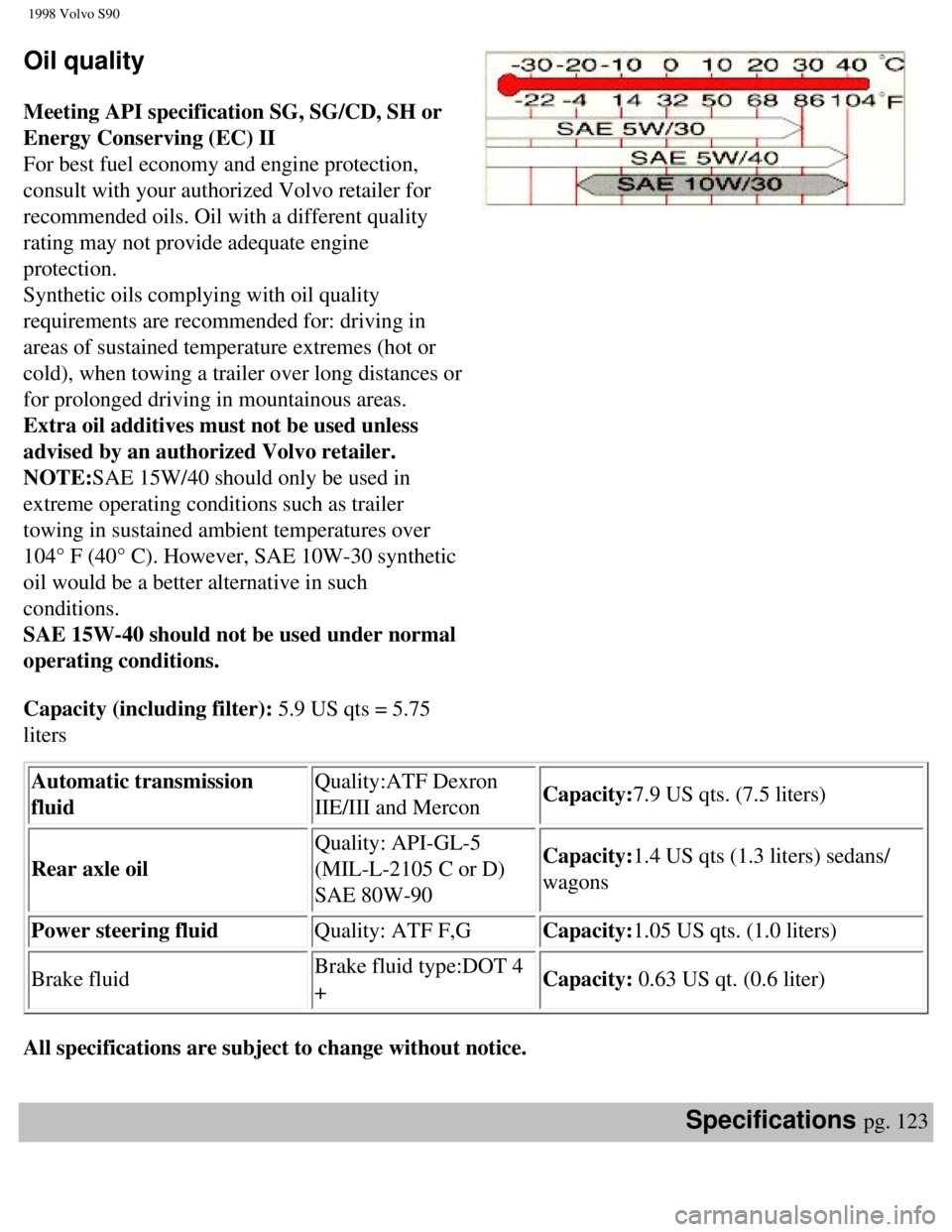
1998 Volvo S90
Oil quality
Meeting API specification SG, SG/CD, SH or
Energy Conserving (EC) II
For best fuel economy and engine protection,
consult with your authorized Volvo retailer for
recommended oils. Oil with a different quality
rating may not provide adequate engine
protection.
Synthetic oils complying with oil quality
requirements are recommended for: driving in
areas of sustained temperature extremes (hot or
cold), when towing a trailer over long distances or
for prolonged driving in mountainous areas.
Extra oil additives must not be used unless
advised by an authorized Volvo retailer.
NOTE:SAE 15W/40 should only be used in
extreme operating conditions such as trailer
towing in sustained ambient temperatures over
104° F (40° C). However, SAE 10W-30 synthetic
oil would be a better alternative in such
conditions.
SAE 15W-40 should not be used under normal
operating conditions.
Capacity (including filter): 5.9 US qts = 5.75
liters
Automatic transmission
fluid Quality:ATF Dexron
IIE/III and Mercon
Capacity:7.9 US qts. (7.5 liters)
Rear axle oil Quality: API-GL-5
(MIL-L-2105 C or D)
SAE 80W-90Capacity:1.4 US qts (1.3 liters) sedans/
wagons
Power steering fluid Quality: ATF F,GCapacity:1.05 US qts. (1.0 liters)
Brake fluid Brake fluid type:DOT 4
+Capacity: 0.63 US qt. (0.6 liter)
All specifications are subject to change without notice.
Specifications pg. 123
file:///K|/ownersdocs/1998/1998_SV90/98S90_121.htm (2 of 4)12/30/2006 \
1:52:50 PM
Page 139 of 175
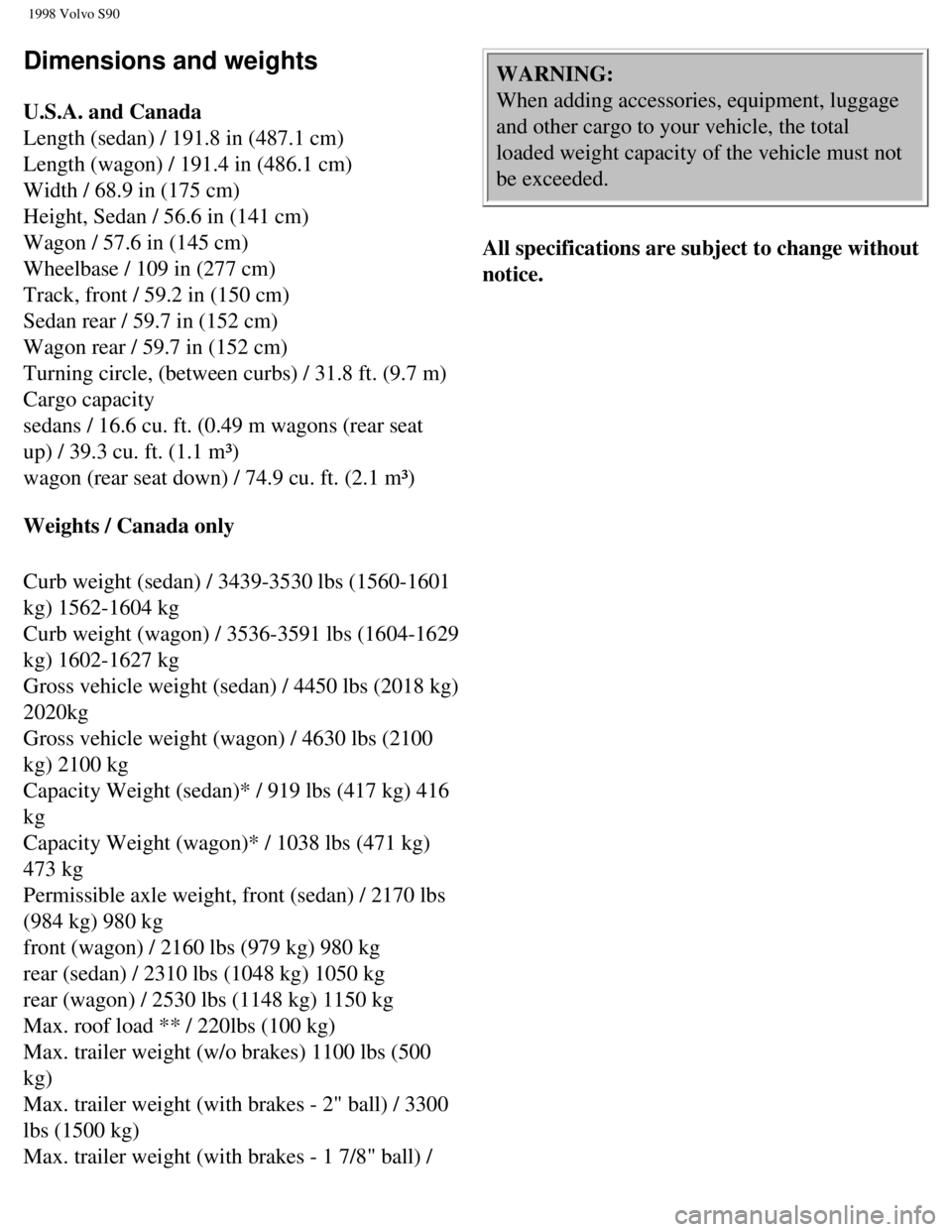
1998 Volvo S90
Dimensions and weights
U.S.A. and Canada
Length (sedan) / 191.8 in (487.1 cm)
Length (wagon) / 191.4 in (486.1 cm)
Width / 68.9 in (175 cm)
Height, Sedan / 56.6 in (141 cm)
Wagon / 57.6 in (145 cm)
Wheelbase / 109 in (277 cm)
Track, front / 59.2 in (150 cm)
Sedan rear / 59.7 in (152 cm)
Wagon rear / 59.7 in (152 cm)
Turning circle, (between curbs) / 31.8 ft. (9.7 m)
Cargo capacity
sedans / 16.6 cu. ft. (0.49 m wagons (rear seat
up) / 39.3 cu. ft. (1.1 m³)
wagon (rear seat down) / 74.9 cu. ft. (2.1 m³)
Weights / Canada only
Curb weight (sedan) / 3439-3530 lbs (1560-1601
kg) 1562-1604 kg
Curb weight (wagon) / 3536-3591 lbs (1604-1629
kg) 1602-1627 kg
Gross vehicle weight (sedan) / 4450 lbs (2018 kg)
2020kg
Gross vehicle weight (wagon) / 4630 lbs (2100
kg) 2100 kg
Capacity Weight (sedan)* / 919 lbs (417 kg) 416
kg
Capacity Weight (wagon)* / 1038 lbs (471 kg)
473 kg
Permissible axle weight, front (sedan) / 2170 lbs
(984 kg) 980 kg
front (wagon) / 2160 lbs (979 kg) 980 kg
rear (sedan) / 2310 lbs (1048 kg) 1050 kg
rear (wagon) / 2530 lbs (1148 kg) 1150 kg
Max. roof load ** / 220lbs (100 kg)
Max. trailer weight (w/o brakes) 1100 lbs (500
kg)
Max. trailer weight (with brakes - 2" ball) / 3300
lbs (1500 kg)
Max. trailer weight (with brakes - 1 7/8" ball) / WARNING:
When adding accessories, equipment, luggage
and other cargo to your vehicle, the total
loaded weight capacity of the vehicle must not
be exceeded.
All specifications are subject to change without
notice.
file:///K|/ownersdocs/1998/1998_SV90/98S90_125.htm (6 of 7)12/30/2006 \
1:52:51 PM
Page 140 of 175
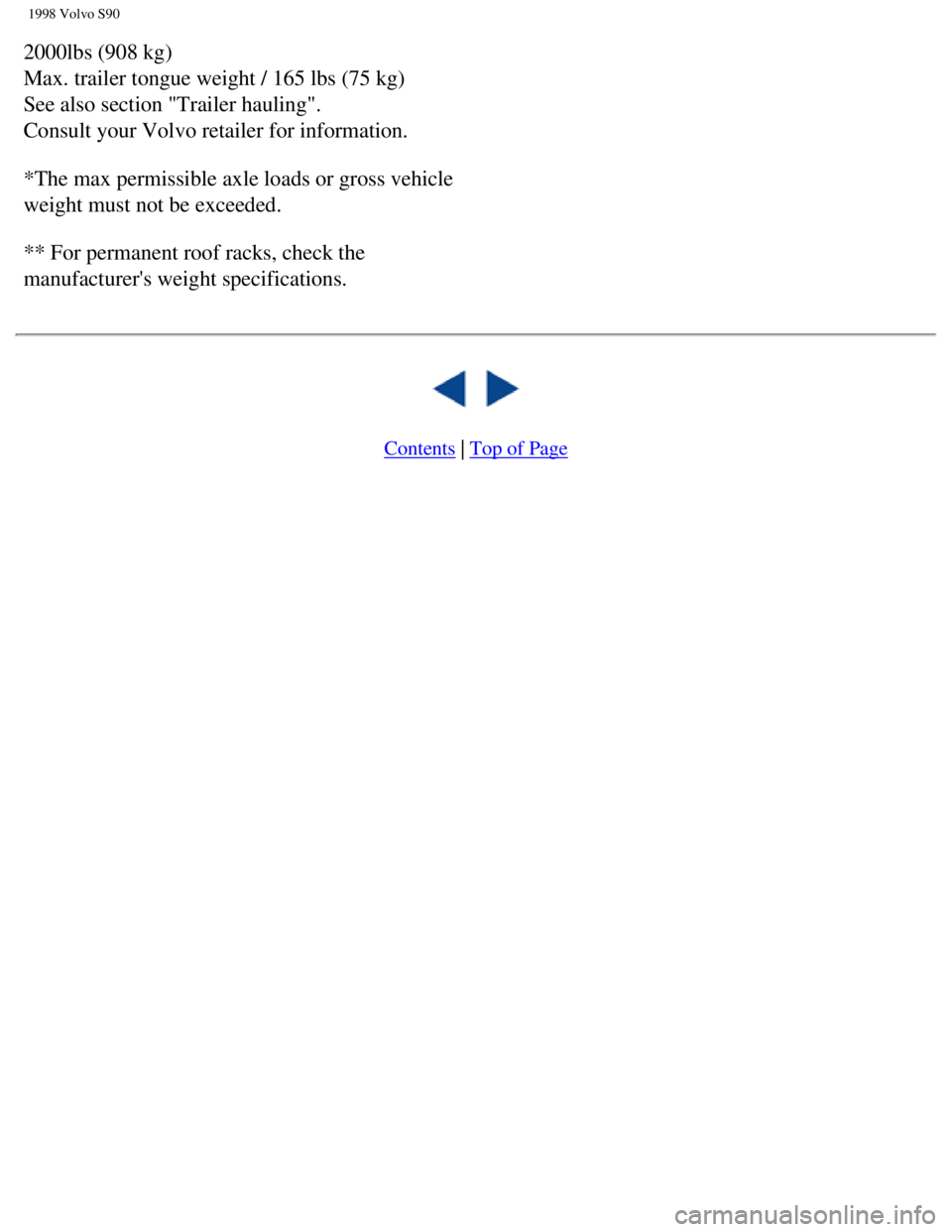
1998 Volvo S90
2000lbs (908 kg)
Max. trailer tongue weight / 165 lbs (75 kg)
See also section "Trailer hauling".
Consult your Volvo retailer for information.
*The max permissible axle loads or gross vehicle
weight must not be exceeded.
** For permanent roof racks, check the
manufacturer's weight specifications.
Contents | Top of Page
file:///K|/ownersdocs/1998/1998_SV90/98S90_125.htm (7 of 7)12/30/2006 \
1:52:51 PM